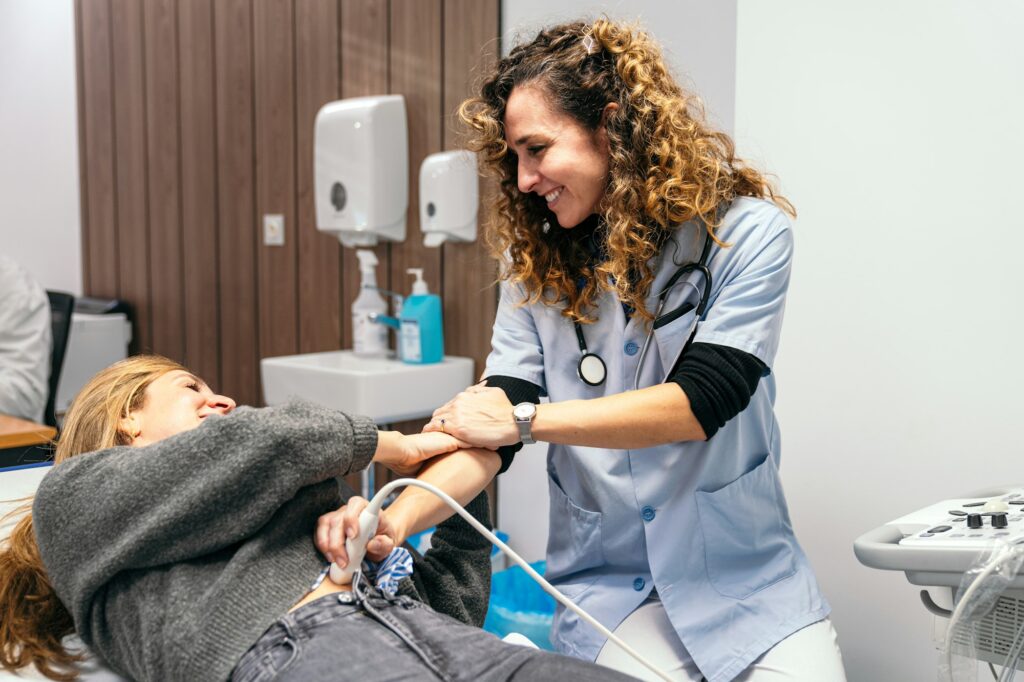15-Week Patient Care Technician (PCT) & Phlebotomy Curriculum
Week 1: Introduction to Healthcare & the PCT Role
- Healthcare System Overview Understanding healthcare settings: hospitals, long-term care, outpatient clinics, home healthcare
- Roles of healthcare professionals: nurses, physicians, PCTs, and others
- PCT responsibilities: key duties, ethical considerations, scope of practice
-
- Patient Rights and Confidentiality Patient rights under HIPAA (Health Insurance Portability and Accountability Act)
- Confidentiality and privacy in healthcare
- Introduction to informed consent
-
- Professionalism in Healthcare Importance of professionalism, including communication, dress code, and behavior
- Maintaining patient dignity and respect
- Understanding cultural competence and diversity in patient care
-
Week 2: Basic Medical Terminology
- Overview of Medical Terminology Prefixes, suffixes, and root words used in medical language
- Common abbreviations and acronyms in healthcare settings
-
- Anatomy and Physiology Review Basic understanding of body systems (e.g., cardiovascular, respiratory, digestive, and musculoskeletal)
- Key medical terms related to body systems and diseases
- Terminology related to common patient conditions and treatments
-
- Medical Charting and Documentation
- Types of patient records: paper vs. electronic health records (EHR)
- Proper documentation practices and terminology
- Understanding medical orders and prescriptions
-
Week 3: Vital Signs & Patient Monitoring
- Understanding Vital Signs Key vital signs: blood pressure, pulse rate, respiratory rate, temperature, and oxygen saturation
- Normal ranges for different age groups
- The role of vital signs in patient care and monitoring
-
- Techniques for Monitoring Vital Signs Theoretical approach to taking vital signs: blood pressure, pulse, temperature, etc.
- Common factors influencing vital signs (age, activity level, health status)
-
- Documenting and Reporting Vital Signs Accurate charting of vital signs in patient records
- Identifying abnormal readings and the importance of reporting them to the healthcare team
-
Week 4: Infection Control & Safety Protocols
- Infection Control Basics Importance of infection control in patient care
- Standard precautions (hand hygiene, PPE, cleaning practices)
- Transmission-based precautions: contact, droplet, and airborne
-
- The Chain of Infection Understanding how infections spread (pathogen, reservoir, portal of entry/exit)
- Ways to break the chain of infection
-
- Workplace Safety Healthcare workplace hazards: physical, chemical, and biological
-
- Fire safety, emergency codes, and disaster protocols
- Fall prevention strategies and safety regulations
-
Week 5: Assisting with Activities of Daily Living (ADLs)
- Overview of ADLs Key activities of daily living: bathing, grooming, dressing, eating, and mobility
- Importance of ADLs in maintaining patient independence
-
- Theory of Patient Mobility and Positioning Understanding body mechanics and positioning techniques to prevent injury
- Importance of preventing pressure ulcers (bedsores)
- Theoretical approaches to using assistive devices (wheelchairs, walkers)
-
- Patient Care in ADLs Recognizing patient needs in ADLs (e.g., assistance, emotional support)
- Communicating effectively with patients during ADL assistance
- Ethical considerations in assisting with personal care
-
Week 6: Phlebotomy & Laboratory Procedures (Theory)
- Introduction to Phlebotomy Basic principles of phlebotomy: blood collection methods (venipuncture, capillary puncture)
- Understanding common blood tests and their purposes (CBC, glucose, lipid profile)
- Theoretical preparation for blood collection: patient identification, blood tube types
-
- Safety Protocols in Phlebotomy Infection control measures during blood collection
- Preventing needlestick injuries and managing exposure to bloodborne pathogens
- Legal and ethical aspects of drawing blood and handling specimens
-
- Lab Procedures and Specimen Handling Overview of common lab tests and specimen types (urine, stool, blood, sputum)
- Proper labeling and handling of specimens
- Chain of custody and confidentiality for laboratory specimens
-
Week 7: EKG Monitoring & Cardiovascular Concepts
- Basic Understanding of EKG The electrical system of the heart and how it relates to an EKG
- Overview of heart anatomy: chambers, valves, and blood flow
- Introduction to common arrhythmias: normal sinus rhythm, bradycardia, tachycardia, atrial fibrillation
-
- Electrocardiogram (EKG) Basics What an EKG measures: heart rate, rhythm, and electrical conduction
- Theoretical understanding of EKG waves: P wave, QRS complex, T wave
- Understanding how to read an EKG strip
-
- The Role of EKG in Patient Monitoring The importance of EKG in diagnosing cardiovascular conditions
- Theoretical preparation for setting up and interpreting EKGs
-
Week 8: Psychological & Emotional Support for Patients
- Understanding Psychological Aspects of Patient Care Psychological stages of illness and the patient’s emotional journey
- Supporting patients with chronic conditions, disabilities, and terminal illnesses
-
- Mental Health Considerations in Patient Care Recognizing signs of mental health disorders (e.g., depression, anxiety, dementia)
- Communicating with patients with mental health conditions
- Providing emotional support to patients and their families
-
- Patient Advocacy and Family Support The PCT’s role as an advocate for the patient’s physical and emotional well-being
- Communicating with families about patient conditions and care plans
-
Week 9: Emergency and Critical Care Procedures
- Basic Life Support (BLS) Overview Theoretical principles of CPR for adults, children, and infants
- The use of an Automated External Defibrillator (AED)
- Emergency response roles for PCTs in critical care settings
-
- Managing Medical Emergencies Recognizing signs of medical emergencies (e.g., stroke, heart attack, respiratory failure)
- Theoretical approach to providing first aid: bleeding control, burns, and fractures
- The role of the PCT in emergency response and assisting nursing and medical teams
-
Week 10: Legal, Ethical, and Professional Issues in Healthcare
- Legal and Ethical Issues in Patient Care Understanding patient rights, consent, and confidentiality
- The ethical dilemma in patient care: autonomy vs. beneficence
- Legal considerations for PCTs: documentation, malpractice, and negligence
-
- Professional Conduct in Healthcare Work ethics, professional boundaries, and handling difficult situations in healthcare
- The importance of continuing education and maintaining certifications
- Exploring the career trajectory and advancement options for PCTs
-
Week 11: Healthcare Technology & Medical Equipment (Theory)
- Medical Equipment and Devices Overview of common medical equipment (e.g., blood pressure cuffs, thermometers, pulse oximeters)
- Theoretical understanding of monitoring devices and how they work
-
- Technology in Patient Care Introduction to Electronic Health Records (EHR) and their role in patient care
- Theoretical knowledge of how healthcare technologies improve patient safety and care delivery
- Ethical and privacy concerns related to health technology
-
Week 12: Review, Exam Preparation, and Final Exam
- Comprehensive Review of Key Concepts Review all major topics: vital signs, infection control, phlebotomy, EKG, patient care, and emergency procedures
- Discussion and clarification of any questions or concepts
-
- Final Written Exam A comprehensive exam covering all theoretical knowledge from the course
- Multiple-choice, short answer, and case study questions
-
- Preparing for Certification Exams Guidance on certifications available for PCTs (CPR, Phlebotomy, EKG)
- Final tips for professional development and job search in the healthcare field
-
3-Week Phlebotomy Curriculum
Week 1: Introduction to Phlebotomy & Foundational Concepts
- Introduction to Phlebotomy Overview of phlebotomy as a profession
- The role of blood collection in healthcare
-
- Responsibilities of a phlebotomist in patient care and diagnostics
- Principles of infection prevention and control in phlebotomy
- Standard precautions: hand hygiene, PPE
- The role of phlebotomists in minimizing infection risk
- Safe practices when working with blood and bodily fluids
- Handling sharps, spills, and hazardous materials
- Following OSHA and safety protocols in the lab
- Overview of body systems with a focus on the circulatory system
- Understanding veins, arteries, and capillaries for effective venipuncture
-
- Infection Control
- Safety Guidelines
- Basic Human Anatomy & Physiology
Week 2: Phlebotomy Techniques & Specialized Procedures
- Phlebotomy Equipment Introduction to essential blood collection tools (needles, vacutainers, collection tubes)
- Types of needles and when to use them
- Proper sterilization and maintenance of equipment
-
- Phlebotomy Techniques Step-by-step venipuncture and capillary collection procedures
- Patient positioning and vein selection
- Minimizing discomfort and ensuring a successful blood draw
-
- Handling Complications & Patient Reactions Common reactions (fainting, hematoma, nausea) and how to manage them
- Identifying and handling complications: arterial puncture, nerve injury
- Strategies to comfort anxious or difficult patients
-
- Special Populations: Pediatric Phlebotomy Techniques for capillary blood collection (fingerstick, heelstick)
- Special considerations for pediatric patients
- Communicating effectively with children and caregivers
-
Week 3: Advanced Phlebotomy Topics & Competencies
- Non-Blood Collection Special Procedures Collection of non-blood specimens (urine, sputum, throat cultures)
- Proper techniques for non-blood sample collection and handling
-
- Sample Preparation & Handling Preparing blood samples for testing (centrifugation, aliquoting)
- Storage and transport guidelines to maintain sample integrity
- Importance of labeling and chain of custody
-
- Customer Service in Phlebotomy Key customer service skills for phlebotomists
- Dealing with difficult patients and providing exceptional care
-
- Legal and Ethical Issues in Phlebotomy Legal considerations (consent, confidentiality, patient rights)
- Ethical responsibilities in phlebotomy: professionalism, accuracy, patient dignity
- Overview of HIPAA and its relevance to phlebotomists
-
- Phlebotomist Competencies Required competencies for effective phlebotomy practice
- Introduction to laboratory tests, specimen requirements, and phlebotomist’s role
- Preparing for certification exams
-


